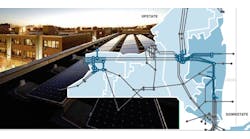New York has issued an energy storage roadmap that uses bridge incentives, wholesale market plays, price signal adjustments and other tools — a swiss army knife approach — to reach 1,500 MW of energy storage by 2025.
Released late last week by Gov. Andrew Cuomo, the roadmap is the latest playbook for Reforming the Energy Vision, an overarching state policy that accelerates use of distributed energy.
Energy storage is increasingly described as a swiss army knife technology because it can serve so many different purposes, from providing onsite backup power to averting expensive grid upgrades. The roadmap exploits these abilities to increase energy storage installations in three arenas: the bulk power market, the distribution system and on customer sites.
The state is pursuing microgrids separately through its NY Prize program, but also sets a place for the technology within the energy storage roadmap. The plan envisions microgrids, along with electric vehicles and solar plus storage, contributing to the 500 MW of energy storage for customer sites.
$350 million bridge incentive
To reach its goals, the state hopes to aid the market in driving down energy storage costs. The plan does this, in part, by offering developers a $350 million bridge incentive, which would be derived from existing revenue sources such as its Clean Energy Fund.
Details have yet to be worked out, but if the bridge incentive is approved by state regulators, it would serve as a way to help energy storage costs drop faster than they already are. The roadmap envisions the incentive decreasing the cost of the 1,500 MW, by as much as $200 million. The incentive also would help soft costs fall by up to $50/kWh for a distribution/bulk‐sited system and up to $150/kWh for a commercial site, according to the energy storage roadmap.
The incentive aside, energy storage projects in New York City’s pricey electricity market “are, or will soon become,” economically viable, the document says. This is particularly true for solar plus storage projects or those installed for commercial facilities or the distribution system.
“By the early 2020s, large numbers of use cases are expected to be economically viable without incentives. This reinforces the need to accelerate the market learning curve now, reduce the amount of soft costs (i.e. non‐hardware costs) embedded in the upfront installed cost, and increase the number of developers working in the state,” the roadmap says.
Already, installed energy storage costs have declined by an average of 10‐15 percent per year since 2010. Lithium ion batteries have experienced the largest drop, but other energy storage technologies are falling in price as well, according to the roadmap.
Credit: New York State Energy Storage Roadmap
Utility role
Utilities would issue procurements for areas on their systems that could benefit from storage. Competitive companies would fulfill the need. In keeping with REV, and the state’s deregulated market, utilities could only develop the projects if the market fails to respond to a need.
To encourage utility support, the plan would create an incentive for utilities in the form a new earnings adjustment mechanism, earned when energy storage improves the distribution system.
The plan also champions non-wires alternatives, or NWAs, to encourage more energy storage. NWAs are distributed energy resources built in lieu of conventional infrastructure, such as power plants and lines.
Broaden NWAs to wholesale markets
New York would broaden opportunities for NWAs under the roadmap to encourage their use in wholesale markets. This would wring greater value from the energy storage and reduce system-wide electricity costs, according to the roadmap.
“This expanded NWA approach is a path toward establishing value sharing between ratepayers, developers and utilities in the future,” says the roadmap.
To incentivize use of energy storage in wholesale markets, the roadmap proposes an incentive, possibly in the form of a fixed capacity payment. Available for up to 100 MW of energy storage, the payment would be designed to create a revenue stream for projects, making them more attractive to financiers.
The roadmap also attempts to help competitive companies build NWAs by requiring utilities make public certain important project information, such as the value of unused land that they own near a potential NWA site.
The report also calls for:
- Improving customer retail delivery rates and programs (like utility dynamic load management) to send more accurate price signals
- Adding incentives for energy storage to the existing NY-Sun initiative to accelerate the development of solar plus storage projects and allow them to access federal tax credits before they expire
- Making regulatory changes to utility rates, utility solicitations and carbon values to reflect the system benefits and values of storage projects
Next step for energy storage roadmap
New York State Energy Storage Roadmap
The roadmap was developed by the Department of Public Service (DPS) and New York State Energy Research and Development Authority. Proposals within the roadmap require approval by the state Public Service Commission, the state’s regulatory arm.
As a next step the state will seek comment on the plan, available on the DPS site.
In conjunction with the roadmap, the NY Green Bank has issued a request for information seeking input from developers on financing gaps for energy storage. With plans to invest at least $200 million in storage-related projects, the green bank intends to issue a request for proposals later this year. The RFP will focus on projects that combine solar and energy storage.
The state sees potential to create up to 30,000 new jobs from the energy storage industry, part of its quest to solidify itself as a clean tech hub.
Follow the New York energy storage roadmap as it evolves. Subscribe to the free Microgrid Knowledge newsletter.







